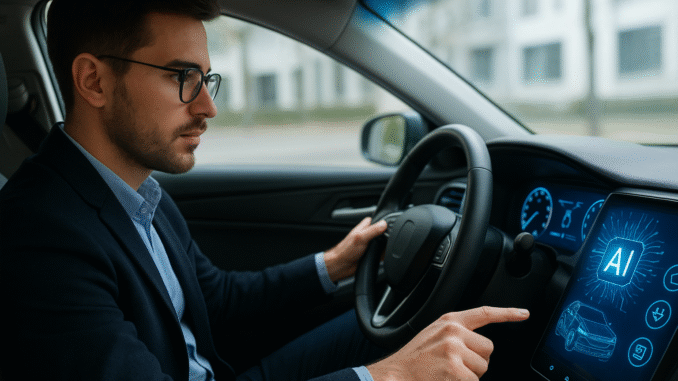
From Engines to Algorithms: How AI Is Driving Innovation in the Automotive Industry
The automotive industry has long been a symbol of technological progress — from Henry Ford’s assembly line to the invention of electric vehicles. But today, another revolution is underway: the integration of artificial intelligence (AI). No longer just about horsepower and design, cars are now becoming intelligent machines capable of learning, predicting, and adapting. This shift from engines to algorithms is redefining how vehicles are built, driven, and experienced — transforming the future of transportation in unprecedented ways.
The Rise of Artificial Intelligence in Automotive Innovation
Artificial intelligence refers to the ability of machines to mimic human intelligence — learning from data, recognizing patterns, and making decisions. In the automotive world, AI is powering everything from design and manufacturing to navigation, maintenance, and autonomous driving.
The last decade has seen a dramatic rise in AI-driven applications within the automotive sector. With the growth of connected cars, massive data generation, and advanced sensors, the need for smart, adaptive systems has never been greater. Whether it’s optimizing fuel efficiency, enhancing safety, or improving driver comfort, AI is now the engine behind the industry’s digital transformation.
1. Smarter Manufacturing: AI in Automotive Production
AI is revolutionizing how cars are made. Traditional production lines are being replaced by intelligent manufacturing systems that analyze data in real time to improve efficiency and reduce waste.
Predictive maintenance is one of the most impactful applications. Sensors installed in factory machinery constantly monitor performance, detecting early signs of wear or malfunction. Instead of reacting to breakdowns, manufacturers can fix issues before they cause downtime — saving time and money.
Robotics and automation are also evolving with AI. Modern robots are not just programmable machines; they can “see” and “learn” using computer vision and machine learning. For instance, AI-powered robots in assembly lines can identify defects, handle complex parts, and even adapt to new models with minimal reprogramming. This flexibility allows automakers to maintain consistent quality while increasing production speed.
Furthermore, AI-driven supply chain management is helping manufacturers forecast demand, manage logistics, and optimize inventory. By analyzing data from global markets, weather conditions, and transportation systems, AI ensures that materials and components arrive just in time — reducing waste and maximizing productivity.
2. Smarter Design: AI in Automotive Engineering
Designing a modern vehicle is an intricate process that balances performance, safety, style, and sustainability. AI has become an indispensable tool for engineers and designers seeking to create cars that are both efficient and appealing.
Generative design, a process powered by AI, enables designers to input specific goals — such as weight reduction, strength, or aerodynamics — and then let algorithms generate thousands of design alternatives. This allows engineers to explore possibilities that would be impossible to conceive manually.
AI also accelerates simulation and testing. Before a vehicle hits the road, it must undergo extensive safety and performance testing. AI-powered simulation platforms can analyze vast datasets to predict how a car will respond to different conditions — from crash scenarios to environmental impacts. This reduces the need for physical prototypes, saving millions in development costs and time.
Even aesthetic design is being influenced by AI. Machine learning tools analyze consumer preferences, market trends, and ergonomic data to help designers create interiors and exteriors that resonate with buyers’ emotions and needs.
3. The Connected Car: AI and the Internet of Things (IoT)
One of the biggest shifts in the automotive landscape is the rise of the connected car — vehicles equipped with internet access and communication systems that interact with other devices, vehicles, and infrastructure.
AI acts as the brain of this ecosystem, processing massive amounts of data from sensors, cameras, and GPS systems to deliver intelligent insights in real time.
For example, AI enables smart navigation systems that do more than provide directions. They learn from traffic patterns, weather conditions, and driver habits to recommend optimal routes, saving time and reducing fuel consumption.
AI also powers personalized driving experiences. Cars can now adjust seat positions, climate control, and music preferences based on who is driving. Voice assistants, powered by natural language processing, allow drivers to control features hands-free, improving both safety and convenience.
Additionally, AI ensures predictive maintenance for vehicles themselves. By analyzing data from sensors, cars can alert drivers to potential problems — such as brake wear or battery failure — before they occur. This reduces repair costs and increases vehicle lifespan.
4. Autonomous Driving: The Ultimate AI Frontier
Perhaps the most groundbreaking application of AI in the automotive industry is autonomous driving. Self-driving cars, once considered science fiction, are now a rapidly advancing reality.
Autonomous vehicles rely on a combination of AI algorithms, computer vision, radar, lidar, and deep learning to perceive their surroundings, make decisions, and navigate safely. These systems constantly process information about road conditions, traffic signals, pedestrians, and other vehicles — reacting in milliseconds to ensure safety.
Companies like Tesla, Waymo, and BMW are leading the charge, each developing their own versions of AI-powered driving systems. While fully autonomous vehicles (Level 5) are still in development, many cars today already feature semi-autonomous systems such as adaptive cruise control, lane-keeping assist, and automatic emergency braking.
The potential benefits of self-driving cars are enormous: fewer accidents caused by human error, reduced traffic congestion, improved mobility for the elderly and disabled, and lower emissions due to optimized driving patterns.
However, challenges remain — particularly regarding safety, legal regulations, and ethical decision-making. Questions such as how a self-driving car should react in unavoidable collision scenarios continue to spark debate. As AI technology matures, building trust and regulatory frameworks will be crucial for widespread adoption.
5. AI in Vehicle Safety and Security
Safety has always been at the heart of automotive innovation, and AI is taking it to new levels.
Modern vehicles are equipped with advanced driver-assistance systems (ADAS) that use AI to monitor the road and alert drivers of potential hazards. These systems rely on computer vision and real-time data processing to detect lane departures, pedestrians, or sudden obstacles — often reacting faster than a human driver.
AI also plays a key role in cybersecurity. As vehicles become more connected, they are increasingly vulnerable to hacking. AI-based systems continuously monitor network activity, identifying unusual patterns or potential cyberattacks before they cause harm. This proactive approach ensures that vehicles remain both safe and secure in an increasingly digital world.
6. Sustainability Through AI: Greener, Smarter Cars
Artificial intelligence is not only making cars smarter — it’s also making them more sustainable.
AI helps optimize energy consumption in both traditional and electric vehicles. For instance, AI algorithms can manage battery performance, predict charging needs, and even suggest the best times to charge based on electricity rates and grid demand.
In electric vehicles (EVs), AI enhances battery management systems (BMS) by analyzing driving habits and environmental conditions to extend battery life. Additionally, AI supports the development of smart charging networks, balancing power distribution and preventing grid overloads during peak times.
In manufacturing, AI-driven analytics reduce waste, improve recycling processes, and promote the use of eco-friendly materials. This combination of intelligence and sustainability is paving the way for a cleaner, greener automotive industry.
7. The Business of AI: New Models and Opportunities
The integration of AI is not only transforming technology but also reshaping business models.
Automakers are shifting from being product manufacturers to mobility service providers. AI-powered platforms enable services like ride-sharing, car subscription models, and fleet management, where data insights optimize routes, reduce costs, and improve customer satisfaction.
Furthermore, the data economy is emerging as a new frontier. Connected vehicles generate massive amounts of data — on driving habits, locations, and vehicle performance. Analyzing this data allows companies to develop better products, targeted services, and personalized experiences for consumers.
Automotive startups are also leveraging AI to disrupt traditional models, focusing on specialized areas like autonomous software, sensor technology, and predictive analytics — fueling competition and accelerating innovation.
8. Challenges and the Road Ahead
Despite its promise, the adoption of AI in the automotive industry comes with challenges.
Data privacy, ethical considerations, and job displacement are ongoing concerns. As cars collect more personal information, ensuring user privacy and data security is essential. Additionally, while automation boosts efficiency, it may impact employment in traditional manufacturing roles.
Technical challenges also persist, including the need for massive data processing power, standardized regulations, and reliable communication infrastructure (such as 5G networks). Overcoming these hurdles will require collaboration between automakers, governments, and tech companies.
Conclusion
From engines to algorithms, the automotive industry is undergoing its most profound transformation since its inception. Artificial intelligence is at the heart of this evolution — making vehicles safer, smarter, and more sustainable.
As cars become increasingly autonomous and connected, they are no longer just machines that move us; they are intelligent companions that understand us, learn from us, and adapt to our needs.
The road ahead may still have challenges, but one thing is certain — AI is the driving force steering the automotive industry toward a future defined by innovation, efficiency, and intelligence.

